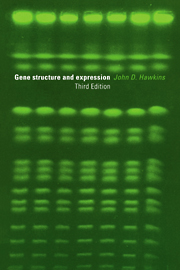Book contents
- Frontmatter
- Contents
- Introduction to the third edition
- Introduction to the second edition
- Introduction to the first edition
- List of abbreviations
- 1 Deoxyribonucleic acid (DNA)
- 2 Ribonucleic acid (RNA)
- 3 Methodology
- 4 Prokaryotic DNA replication and gene expression
- 5 The operon concept
- 6 Eukaryotic gene organisation and replication
- 7 Eukaryotic transcription
- 8 Post-transcriptional processing of RNA
- 9 Oncogenes
- 10 Haemoglobin
- 11 Proteins of the immune system
- 12 Some gene families
- 13 Mitochondrial and chloroplast genomes
- 14 Different and evolving genomes
- Glossary
- Reading lists
- Index
1 - Deoxyribonucleic acid (DNA)
Published online by Cambridge University Press: 05 June 2012
- Frontmatter
- Contents
- Introduction to the third edition
- Introduction to the second edition
- Introduction to the first edition
- List of abbreviations
- 1 Deoxyribonucleic acid (DNA)
- 2 Ribonucleic acid (RNA)
- 3 Methodology
- 4 Prokaryotic DNA replication and gene expression
- 5 The operon concept
- 6 Eukaryotic gene organisation and replication
- 7 Eukaryotic transcription
- 8 Post-transcriptional processing of RNA
- 9 Oncogenes
- 10 Haemoglobin
- 11 Proteins of the immune system
- 12 Some gene families
- 13 Mitochondrial and chloroplast genomes
- 14 Different and evolving genomes
- Glossary
- Reading lists
- Index
Summary
The genetic material
The classic experiments of Avery in 1944 demonstrated that DNA (Deoxyribonucleic acid) passes genetic information from one bacterium to another. Strain-specific properties of related bacteria could be transferred by DNA that was free of proteins and other substances. DNA is a polymeric molecule built up from only four similar but distinct monomers – nucleotides that are the 5′-phosphates of deoxyguanosine (dGMP), deoxyadenosine (dAMP), deoxycytidine (dCMP), and thymidine (TMP) (Fig. 1.1), joined by phosphodiester linkages between the 3′- and 5′-positions of successive deoxyribose moieties. The initial letters of the bases in the nucleotides are used as abbreviations when writing out their sequence in DNA. The symbols N, R and Y denote any nucleotide, a purine nucleotide and a pyrimidine nucleotide respectively.
DNA is a polar helical molecule
One end of a DNA molecule has a phosphoryl radical on the C-5′ of its terminal nucleotide, while the other end possesses a free -OH on the C-3′ of its nucleotide. Thus a poly nucleotide exhibits polarity in an analogous way to that of proteins with free -NH2 and -COOH groups at their ends. The tetranucleotides TCGA and AGCT are different chemical entities with distinct properties, even though they behave very similarly in many respects (Fig. 1.2). By convention, sequences of DNA are written with the nucleotide containing the free phosphoryl radical at the left. Sequences to the left of a given nucleotide are said to be on the 5′-side (often called upstream), and those to the right are said to be on the 3′-side (often called downstream).
- Type
- Chapter
- Information
- Gene Structure and Expression , pp. 1 - 18Publisher: Cambridge University PressPrint publication year: 1996



